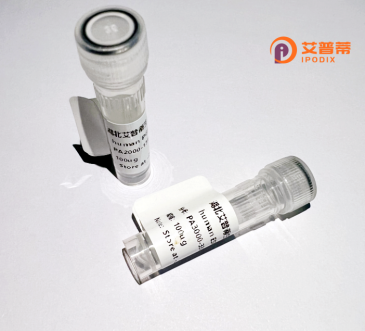
| 纯度 | >90%SDS-PAGE. |
| 种属 | Human |
| 靶点 | TMCO1 |
| Uniprot No | Q9UM00 |
| 内毒素 | < 0.01EU/μg |
| 表达宿主 | E.coli |
| 表达区间 | 1-188 aa |
| 活性数据 | MSTMFADTLLIVFISVCTALLAEGITWVLVYRTDKYKRLKAEVEKQSKKLEKKKETITESAGRQQKKKIERQEEKLKNNNRDLSMVRMKSMFAIGFCFTALMGMFNSIFDGRVVAKLPFTPLSYIQGLSHRNLLGDDTTDCSFIFLYILCTMSIRQNIQKILGLAPSRAATKQAGGFLGPPPPSGKFS |
| 分子量 | 47.6 kDa |
| 蛋白标签 | GST-tag at N-terminal |
| 缓冲液 | PBS, pH7.4, containing 0.01% SKL, 1mM DTT, 5% Trehalose and Proclin300. |
| 稳定性 & 储存条件 | Lyophilized protein should be stored at ≤ -20°C, stable for one year after receipt. Reconstituted protein solution can be stored at 2-8°C for 2-7 days. Aliquots of reconstituted samples are stable at ≤ -20°C for 3 months. |
| 复溶 | Always centrifuge tubes before opening.Do not mix by vortex or pipetting. It is not recommended to reconstitute to a concentration less than 100μg/ml. Dissolve the lyophilized protein in distilled water. Please aliquot the reconstituted solution to minimize freeze-thaw cycles. |
以下是关于重组人TMCO1蛋白的3篇参考文献的简要信息:
1. **文献名称**:*TMCO1 is an endoplasmic reticulum calcium load sensor regulating neuronal excitability and survival*
**作者**:Wang et al.
**摘要**:该研究发现TMCO1作为内质网钙离子水平的传感器,通过调控钙稳态维持细胞存活。重组TMCO1蛋白实验揭示其缺陷会导致钙过载诱导的细胞凋亡,并与神经元退行性疾病相关。
2. **文献名称**:*TMCO1 guides ATF5-mediated adaptive mitochondrial UPR to prevent Parkinson’s disease-like pathology*
**作者**:Liu et al.
**摘要**:研究证明重组TMCO1蛋白通过与ATF5相互作用调控线粒体未折叠蛋白反应(UPR),减少α-突触核蛋白异常聚集,为帕金森病治疗提供新靶点。
3. **文献名称**:*Structural insights into the function of TMCO1 in calcium homeostasis*
**作者**:Chen & Zhang
**摘要**:通过重组TMCO1蛋白的晶体结构解析,揭示其跨膜区及螺旋结构域在钙离子通道调控中的分子机制,阐明其突变导致青光眼等疾病的分子基础。
以上文献聚焦TMCO1在钙稳态、神经退行性疾病及结构生物学中的功能。
TMCO1 (Transmembrane and Coiled-Coil Domains 1) is a highly conserved endoplasmic reticulum (ER)-resident protein critical for maintaining calcium ion (Ca²⁺) homeostasis. It functions as a Ca²⁺ leak channel, actively preventing ER overfilling by releasing excess Ca²⁺, thereby safeguarding cells from ER stress-induced apoptosis. Structurally, TMCO1 contains a transmembrane domain and coiled-coil motifs, enabling its integration into the ER membrane and facilitating protein-protein interactions. Its role in Ca²⁺ regulation intersects with diverse cellular processes, including protein folding, lipid synthesis, and signal transduction.
Genetic studies link TMCO1 mutations to human diseases. Notably, autosomal recessive TMCO1 defects cause a rare developmental disorder termed "TMCO1 defect syndrome," characterized by craniofacial dysmorphism, skeletal anomalies, and intellectual disability. Conversely, altered TMCO1 expression is implicated in primary open-angle glaucoma (POAG), where its dysregulation may disrupt ocular drainage pathways. In cancer, TMCO1 overexpression in certain tumors correlates with poor prognosis, suggesting context-dependent roles in proliferation or metastasis.
Recombinant human TMCO1 protein, typically produced via heterologous expression systems (e.g., E. coli or mammalian cells), enables mechanistic studies of its Ca²⁺ channel activity and interactions. This tool is pivotal for screening therapeutic compounds targeting TMCO1-associated pathologies or deciphering its structural biology using techniques like crystallography. Ongoing research aims to clarify its tissue-specific regulatory networks and potential as a biomarker or therapeutic target.
×